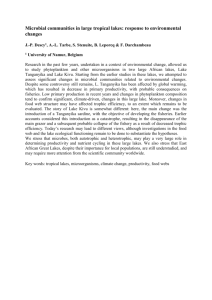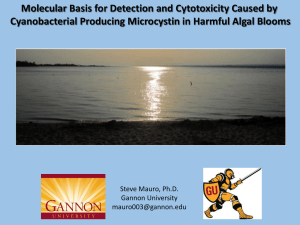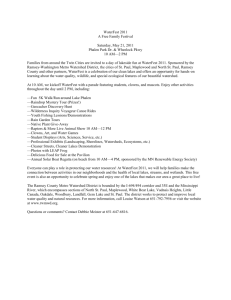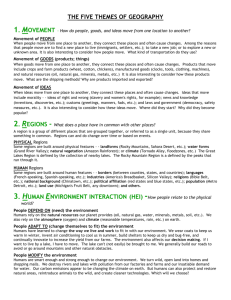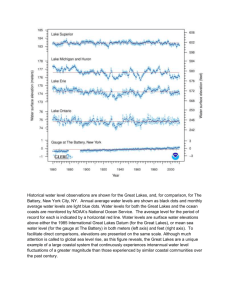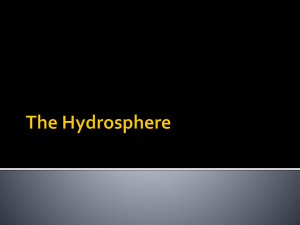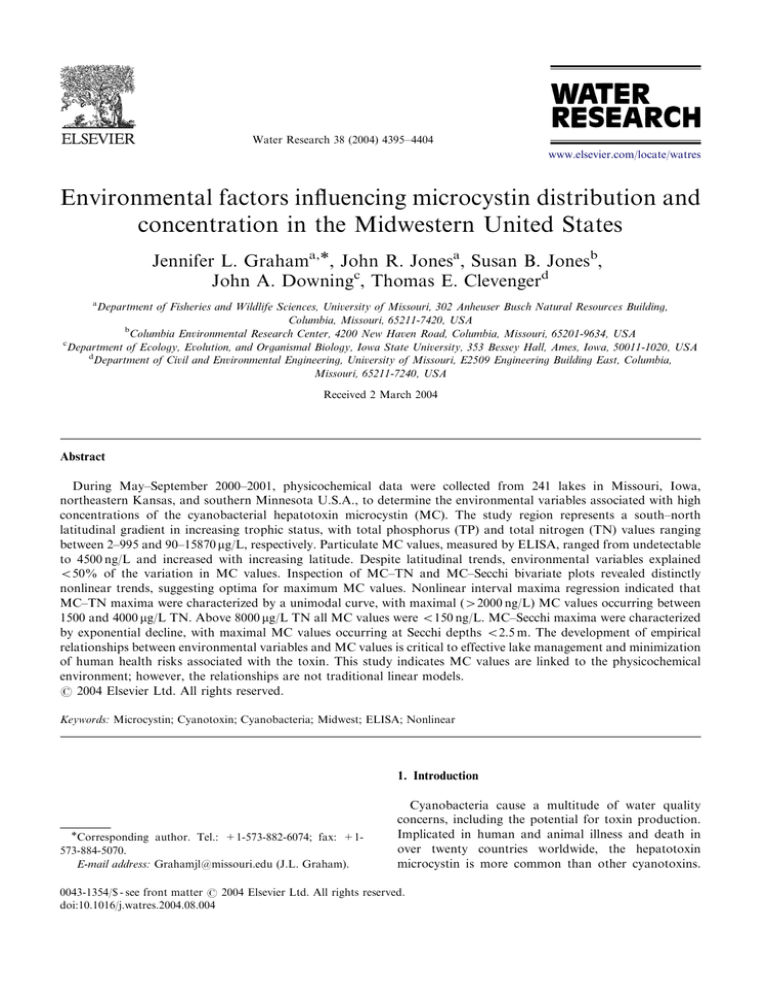
ARTICLE IN PRESS
Water Research 38 (2004) 4395–4404
www.elsevier.com/locate/watres
Environmental factors influencing microcystin distribution and
concentration in the Midwestern United States
Jennifer L. Grahama,, John R. Jonesa, Susan B. Jonesb,
John A. Downingc, Thomas E. Clevengerd
a
Department of Fisheries and Wildlife Sciences, University of Missouri, 302 Anheuser Busch Natural Resources Building,
Columbia, Missouri, 65211-7420, USA
b
Columbia Environmental Research Center, 4200 New Haven Road, Columbia, Missouri, 65201-9634, USA
c
Department of Ecology, Evolution, and Organismal Biology, Iowa State University, 353 Bessey Hall, Ames, Iowa, 50011-1020, USA
d
Department of Civil and Environmental Engineering, University of Missouri, E2509 Engineering Building East, Columbia,
Missouri, 65211-7240, USA
Received 2 March 2004
Abstract
During May–September 2000–2001, physicochemical data were collected from 241 lakes in Missouri, Iowa,
northeastern Kansas, and southern Minnesota U.S.A., to determine the environmental variables associated with high
concentrations of the cyanobacterial hepatotoxin microcystin (MC). The study region represents a south–north
latitudinal gradient in increasing trophic status, with total phosphorus (TP) and total nitrogen (TN) values ranging
between 2–995 and 90–15870 mg/L, respectively. Particulate MC values, measured by ELISA, ranged from undetectable
to 4500 ng/L and increased with increasing latitude. Despite latitudinal trends, environmental variables explained
o50% of the variation in MC values. Inspection of MC–TN and MC–Secchi bivariate plots revealed distinctly
nonlinear trends, suggesting optima for maximum MC values. Nonlinear interval maxima regression indicated that
MC–TN maxima were characterized by a unimodal curve, with maximal (42000 ng/L) MC values occurring between
1500 and 4000 mg/L TN. Above 8000 mg/L TN all MC values were o150 ng/L. MC–Secchi maxima were characterized
by exponential decline, with maximal MC values occurring at Secchi depths o2.5 m. The development of empirical
relationships between environmental variables and MC values is critical to effective lake management and minimization
of human health risks associated with the toxin. This study indicates MC values are linked to the physicochemical
environment; however, the relationships are not traditional linear models.
r 2004 Elsevier Ltd. All rights reserved.
Keywords: Microcystin; Cyanotoxin; Cyanobacteria; Midwest; ELISA; Nonlinear
1. Introduction
Corresponding author. Tel.: +1-573-882-6074; fax: +1573-884-5070.
E-mail address: Grahamjl@missouri.edu (J.L. Graham).
Cyanobacteria cause a multitude of water quality
concerns, including the potential for toxin production.
Implicated in human and animal illness and death in
over twenty countries worldwide, the hepatotoxin
microcystin is more common than other cyanotoxins.
0043-1354/$ - see front matter r 2004 Elsevier Ltd. All rights reserved.
doi:10.1016/j.watres.2004.08.004
ARTICLE IN PRESS
4396
J.L. Graham et al. / Water Research 38 (2004) 4395–4404
Over fifty microcystin variants have been isolated from
thirteen cyanobacterial genera, likely contributing to the
global occurrence of the toxin (Carmichael, 1997;
Chorus, 2001).
Knowledge of microcystin occurrence and understanding factors associated with high concentrations are
critical to effective lake management and minimization
of health risks associated with the hepatotoxin. Current
studies indicate a complex range of physicochemical
variables influence microcystin production, and no one
variable stands out as an unequivocal link to toxicity.
Cyanobacterial blooms are often composed of both
toxic and nontoxic strains (Vézie et al., 1998), and
laboratory experiments have demonstrated that environmental influences on microcystin production are
strain dependent (Sivonen, 1990; Vézie et al., 2002).
Environmental variables are therefore likely to influence
microcystin concentrations directly, by influencing
cellular microcystin production and content (Orr and
Jones, 1998; Long et al., 2001), and indirectly, by
influencing cyanobacterial species and strain composition (Chorus, 2001; Vézie et al., 2002). Regional studies
of microcystin in relation to physicochemical variables
provide valuable information on what environmental
conditions are most likely to result in high microcystin
concentrations (Chorus, 2001); however, relative to the
number of regional studies that have been conducted,
empirical relationships between microcystin and environmental factors have seldom been developed.
Cyanotoxic incidents have been reported in the
Midwestern United States for over a century, but little
research has been done in the region (Yoo et al., 1995).
Surveys in Wisconsin and Kansas indicate microcystin is
common (McDermott et al., 1995; Dodds, 1996),
and the toxin has been detected in finished drinking
water (Chu and Wedepohl, 1994). Thus, microcystin
represents a potential health risk in Midwestern
water resources. Lakes in Missouri, Iowa, northeastern
Kansas, and southern Minnesota were sampled during
summers 2000–2001 to document microcystin occurrence and develop empirical relationships between the
physicochemical environment and microcystin concentration.
2. Materials and methods
2.1. Study area
Lakes (n=241) were located within four physiographic provinces: the Ozark Highlands, Osage
Plains, Dissected Till Plains, and Western Lake Section
(Fenneman, 1938, Fig. 1). Limnological differences
among provinces have been well characterized and are
associated with geology and land use. Due to rich glacial
soils and a landscape dominated by row-crop agriculture
the Western Lake Section has nutrient enriched lakes
that support high levels of algal biomass. In contrast, the
Ozark Highlands, with poor quality soils and little rowcrop agriculture, tends to have lakes with low nutrient
levels and algal biomass. Lakes in the Osage and
Dissected Till Plains are intermediate between lakes
Fig. 1. Physiographic location of lakes sampled and regional trends in microcystin occurrence. Open triangles indicate lakes where
microcystin (MC) was detected. Closed circles indicate lakes where MC was not detected.
ARTICLE IN PRESS
J.L. Graham et al. / Water Research 38 (2004) 4395–4404
located in the southern- and northern-most provinces
(Jones and Bachmann, 1978; Jones and Knowlton,
1993). Generally, the region represents a south–north
gradient in increasing trophic status, with lakes located
farther north having many characteristics conducive to
cyanobacterial dominance.
2.2. Sample collection
A total of 800 lake visits were made during
May–September 2000–2001; most lakes were sampled
2–4 times during one or both years. Six University of
Missouri (MU) studies and an Iowa State University
(ISU) study collected algal samples for particulate
microcystin (MC) analysis. All studies measured Secchi
transparency and surface temperature (1C) and analyzed
composite surface or integrated epilimnetic samples for
total phosphorus (TP), total nitrogen (TN), TN:TP
ratio, volatile (VSS), nonvolatile (NVSS), and total
suspended solids (TSS), chlorophyll (Chl), and Chl:TP
ratio. Additionally, ISU (lake n=132) determined
phytoplankton community structure.
At MU, TP was determined using ascorbic acid (Eaton
et al., 1995), and TN by persulfate oxidation (Crumpton
et al., 1992). Suspended solids were collected on 1.2 mm
Whatman GF/C filters; VSS was calculated by taking the
difference between TSS and NVSS (Eaton et al., 1995).
Chl was collected on 1.0 mm Pall A/E filters, extracted in
heated ethanol and analyzed fluorometrically (Knowlton, 1984; Sartory and Grobbelar, 1986). Detailed ISU
methods are given in Downing and Ramstack (2000).
Though produced by cyanobacteria of all size classes,
toxic incidents involving MC are most frequently
associated with large, surface bloom forming genera
(Chorus and Bartram, 1999; Chorus, 2001). Thus, when
algal cells464 mm were present, 20 L of surface water
was concentrated for particulate MC analysis using a
64 mm plankton net (Kotak et al., 2000; Chorus, 2001).
Samples were frozen, then lyophilized and stored at
80 1C. ISU sent samples to MU for analysis. The mass
of seston464 mm (mg/L, dry weight) was measured and
MC was extracted from 10 mg sub-samples using
deionized water. Envirogards ELISA kits (detection
limit: 100 ng/L) were used to determine MC concentration in seston extracts. MC measured by ELISA includes
the variants -LR, -RR, and -YR, as well as nodularian.
Particulate MC values were expressed volumetrically by
multiplying the seston mass (mg/L d.w.) by the MC
content of the seston (mg/g seston d.w., Chorus, 2001);
values were re-expressed as ng/L.
2.3. Statistical analyses
Relationships between particulate MC values and
environmental variables were developed using nonparametric Spearman–Rank correlation (a=0.05).
4397
Bivariate plots of the relationships between particulate MC and environmental variables showed non-linear
trends that were not linearized through transformation.
MC was undetectable across the range of all variables;
therefore, the shape of any given relationship was
defined by the upper limits created by MC maxima.
To characterize the relationships between MC and
environmental variables we used interval maxima
regression (IMR). Each variable was divided into equal
increments, resulting in 6–16 intervals. The maximum
MC value and the associated environmental variable
value were obtained from each interval and used in
nonlinear regression analysis (Blackburn et al., 1992;
Scharf et al., 1998).
Nonlinear regression is an iterative fitting analysis in
which the form of the relationship between variables
must be specified (Snedecor and Cochran, 1989).
Inspection of bivariate plots revealed two relationships,
which we defined as log-normal 3-parameter
y ¼ ae½0:5ðlnðx=x0Þ=bÞ
^
2
(1)
and inverse first-order polynomial
y ¼ y0 þ a=x;
(2)
where x=the value of the environmental variable and a,
b, x0 ; and y0 are estimated coefficients. A curve fitter
(SigmaPlots 2001) employing a least-squares method
was used to fit equations and estimate coefficients
(tolerance=0.0001, step size=100, and iterations=100).
This is a parametric analysis and the assumptions
of normality and heteroscedasticity were generally
met. IMR relationships were considered significant at
a ¼ 0:05:
3. Results
3.1. Descriptive limnology
A diverse range of lake conditions was encountered in
the study region wherein TP (2–955 mg/L), TN
(90–15870 mg/L), and Chl (1–546 mg/L) values spanned
2–3 orders of magnitude (Table 1). Nutrient values were
lowest in the Ozark Highlands and increased moving
northward through the Osage Plains and into the
Dissected Till Plains and Western Lake Section, with
median values nearly doubling between each province,
respectively (Table 1). The majority of lakes in the
Ozark Highlands (73%) were classified as oligo- or
mesotrophic, while in all other provinces most lakes
(485%) were either eu- or hypereutrophic (Nürnberg,
1996).
TN:TP ratios ranged from 1 to 429, and varied widely
within provinces (Table 1). Based on TN:TP ratios, the
majority of lakes in the study region were potentially Plimited (46%, TN:TP4 17) or co-limited (30%,
ARTICLE IN PRESS
J.L. Graham et al. / Water Research 38 (2004) 4395–4404
4398
Table 1
Provincial medians (med) and ranges of limnological variables
Variable
Zmean (m)
Area (ha)
TP (mg/L)
TN (mg/L)
TN:TP
Chl (mg/L)
TSS (mg/L)
Chl:TP
NVSS (mg/L)
VSS (mg/L)
Secchi (m)
1C
CBV (mm3/L)
Ozark Highlands
Osage Plains
n
Med
Range
n
Med
22
22
92
92
92
92
92
92
92
92
92
92
0
7.1
72
12
405
26
5
2.6
0.4
1.1
1.3
2.2
28.0
2.4–20.7
12–20755
2–182
90–1080
5–97
1–105
0.6–17.7
0.1–1.9
0.1–10.2
0.2–13.3
0.4–8.6
19.9–34.4
25
18
111
111
111
111
111
111
111
111
111
111
0
2.9
42
45
730
16
22
10.0
0.5
5.3
4.3
0.8
27.2
Dissected Till Plains
Western Lake Section
Range
n
Med
Range
n
Med
Range
1.9–7.3
10–21733
17–178
360–2670
5–35
3–106
2.5–39.3
o0.1–1.1
0.1–31.7
1.0–16.3
0.1–3.0
8.3–34.3
88
132
435
434
431
431
419
426
419
419
437
432
218
3.1
27.9
79
1091
14
18
8.6
0.3
3.9
4.0
0.8
27.4
5.8e9
0.9–14.9
4–7689
5–721
290–9445
3–227
o1–286
0.1–177.9
o0.1–2.5
0.1–151.2
0.1–70.0
0.1–4.3
16.7–32.9
0–1.0e12
43
47
157
158
157
152
153
159
153
153
156
153
84
2.9
153
141
1956
14
37
19.0
0.3
7.9
9.0
0.5
24.6
7.3e9
0.9–11.6
6–2300
12–995
236–15870
1–429
1–546
1.5–295.0
o0.1–2.3
0.1–207.0
0.2–120.0
0.1–6.3
14.1–38.9
0–4.7e11
n indicates the number of lake visits in which each variable was measured, with the exception of Zmean and area, where n indicates
number of lakes. Cyanobacterial biovolume (CBV) was not measured for all lake visits.
17oTN:TP410) by P and N; only 24% of lakes were
potentially N-limited (TN:TPo10, Forsberg and
Ryding, 1980). Chl:TP ratios 1 indicate algae are
not P-limited, while ratios ffi 1 are indicative of
potential P-limitation (White, 1989). In the study region,
Chl:TP ratios ranged from o0.01–2.5 (Table 1);
however, only 10% of lakes considered P-limited by
the TN:TP ratio had Chl:TP ratios40.8, suggesting
factors other than nutrients may commonly limit algal
growth.
Cyanobacterial community structure was assessed for
302 lake visits in the Dissected Till Plains and Western
Lake Section. Four genera known to produce MC,
Anabaena, Coelosphaerium, Microcystis, and Oscillatoria
(Yoo et al., 1995), were present in 91% of lake visits.
Cyanobacterial biovolume (CBV) was generally dominated (450% total CBV) by the MC producing genera
(81% of lake visits), with Oscillatoria dominating most
frequently (48%), followed by Microcystis (17%),
Coelosphaerium (11%), and Anabaena (5%).
3.2. Microcystin occurrence and concentration
Algae464 mm were collected for particulate MC
analysis during 58% of lake visits; of the algal samples
collected, 98% had detectable MC. Overall, MC was
detected at least once in 78% of lakes sampled. But, in
northern provinces there was a greater incidence of
MC: 85% of Dissected Till Plain and 100% of Western
Lake Section lakes had detectable MC, compared to
26% in the Ozark Highlands and 44% in the Osage
Plains (Fig. 1).
Table 2
Regional medians and ranges of microcystin values
Region
Ozark Highlands
Osage Plains
Dissected Till Plains
Western Lake Section
Microcystin (ng/L)
n
Median
Range
92
111
439
158
0a
0a
2b
27c
0–43
0–189
0–2933
0–4501
n indicates the number of lake visits in each region. Letters
indicate significant differences in median concentrations (Kruskal–Wallis, po0.01).
Particulate MC values ranged from undetectable to
4501 ng/L. Although spanning a wide range, 75% of
MC values were o26 ng/L and only 2% of values
were41000 ng/L. Median MC values were significantly
greater in northern provinces (Kruskal–Wallis: H ¼
237; df ¼ 3; po0.01), increasing from 0 ng/L in the
Ozark Highlands and Osage Plains to 27 ng/L in the
Western Lake Section (Table 2). Likewise, maximal MC
values in the Dissected Till Plains and Western Lake
Section were an order of magnitude greater than in the
Osage Plains and two orders of magnitude greater than
in the Ozark Highlands (Table 2).
3.3. Correlation analysis
Particulate MC was significantly correlated with
latitude, nutrients, TN:TP ratio, Chl, Chl:TP ratio,
ARTICLE IN PRESS
J.L. Graham et al. / Water Research 38 (2004) 4395–4404
suspended solids, Secchi depth, 1C, and Zmean (Table 3).
Latitude (r=0.66), TN (r=0.59), and TP (r=0.46) were
most highly correlated with MC. In lakes where
cyanobacterial biovolume was assessed, MC was positively correlated with CBV (r=0.32). Latitude was
also significantly correlated with environmental variables (Table 3), suggesting the latitudinal increase in
MC values was related to changing environmental
conditions.
3.4. Interval maxima regression (IMR)
The strong latitudinal gradients in environmental
variables and MC presence and concentration, indicate
there is a relationship between MC and the physicochemical environment. Despite significant correlations,
environmental variables explained o50% of the variation in MC values (Table 3). Correlation analysis
measures the closeness of linear relationship between
two variables (Snedecor and Cochran, 1989); however,
inspection of the maxima in MC–TN and MC–Secchi
bivariate plots showed two distinctly non-linear trends.
The MC–TN maxima were characterized by a
unimodal curve (r2=0.84, n=14, po0.01). Along the
TN gradient the greatest MC values (42000 ng/L)
occurred between 1500 and 4000 mg/L; MC values were
o150 ng/L above 8000 mg/L TN (Fig. 2a). By comparison, MC–Secchi maxima were characterized by exponential decline (r2=0.75, n=16, po0.01)(Fig. 2b). MC
values were o150 ng/L above Secchi depths of 2.5 m.
The relationships observed along the regional TN and
Secchi gradients were reflected in individual lakes. For
example, in Beeds Lake, Iowa, TN values ranged from
Table 3
Spearman Rank correlations (rs) between microcystin (MC),
latitude (LAT), and environmental variables
Variable
Latitude
TN (mg/L)
TP (mg/L)
VSS (mg/L)
CBV (mm3/L)
Chl (mg/L)
Zmean (m)
TSS (mg/L)
Secchi (m)
NVSS (mg/L)
TN:TP
1C
Chl:TP
Area (Ha)
n
800
795
795
775
302
786
621
775
796
775
791
788
781
716
MC
LAT
rs
p
rs
p
0.66
0.58
0.46
0.36
0.32
0.30
0.30
0.29
0.27
0.17
0.15
0.10
0.07
0.02
o0.01
o0.01
o0.01
o0.01
o0.01
o0.01
o0.01
o0.01
o0.01
o0.01
o0.01
o0.01
0.03
0.52
—
0.66
0.56
0.35
0.14
0.21
0.27
0.31
0.26
0.23
0.20
0.19
0.26
0.07
—
o0.01
o0.01
o0.01
0.01
o0.01
o0.01
o0.01
o0.01
o0.01
o0.01
o0.01
o0.01
0.06
4399
1800 to 12700 mg/L (n=8), but maximal MC values were
only observed at TN values p4000 mg/L (Fig. 3a). And,
in West Okoboji, Iowa, where Secchi values ranged from
0.6 to 6.2m, MC maxima were observed at Secchi depths
o2.5 m (Fig. 3b).
IMR analysis was also performed using CBV.
CBV–TN (r2=0.94, n=15, po0.01), and CBV–Secchi
(r2=0.76, n=11, po0.01) relationships were strikingly
similar to MC relationships. Like MC, the greatest CBV
values (4211 mm3/L) occurred within a TN range of
1500–4000 mg/L and at Secchi depths o2.5 m (Fig. 2c
and d). The subset of MC values in lakes where CBV
was measured show similar upper limit trends as the
overall relationship (Fig. 2a and b), but MC and CBV
values were not tightly coupled (r=0.32).
Other bivariate plots between MC, CBV, and
environmental variables had maxima described by either
exponential decline or unimodal curves. For example,
the TN:TP relationship was characterized by exponential decline. And, the TP relationship could be fitted with
a unimodal curve, although the curve was not significant
(p=0.17). Peak MC and CBV values occurred when
TN:TPo50 and within a TP range of 200–600 mg/L
(Fig. 4).
While cyanobacterial community composition did not
change markedly along the environmental gradients,
overall phytoplankton community structure changed
substantially. At TN values o8000 mg/L the Cyanophyta dominated (450% of total phytoplankton biovolume) 71% of lake visits (n=280), compared to only
24% at TN values48000 mg/L (n=17). Similar trends
were observed along the Secchi and TN:TP gradients,
with 70% of lake visits dominated by Cyanophyta at
Secchi o2.5 m (n=278) and TN:TP o50 (n=264),
compared to only 50% at Secchi42.5 m (n=21) and
TN:TP450 (n=30). At TN48000 mg/L, Secchi42.5 m,
and TN:TP450 Bacillariophyta and Chlorophyta were
the dominant phytoplankton groups. Unlike TN,
Secchi, and TN:TP, the Cyanophyta remained dominant
along the entire TP gradient.
4. Discussion
The study region represents a latitudinal gradient in
trophic status (Table 1), thereby providing a unique
context in which to examine MC concentration with
respect to the physicochemical environment. MC presence, and median and maximum values, increased
along the trophic gradient (Table 2, Fig. 1), indicating
environmental factors play a role in determining MC
occurrence and maxima. Nutrient values were greater,
and Secchi depths shallower in the Dissected Till Plains
and Western Lake Section, where MC was detected
most frequently (Table 1, Fig. 1), conditions known
to favor cyanobacteria (Reynolds, 1998). MC is
ARTICLE IN PRESS
J.L. Graham et al. / Water Research 38 (2004) 4395–4404
4400
r2=0.84
5000
4000
4000
3000
3000
2000
2000
1000
1000
0
0
r2=0.94
1.1e+12
7.0e+11
7.0e+11
5.0e+11
5.0e+11
3.0e+11
3.0e+11
1.0e+11
1.0e+11
1.0e+10
1.0e+7
4
5
6
7
8
9
10
r2=0.76
0
00
0
16
00
0
18
00
0
0
1
2
3
4
5
6
7
14
0
00
12
00
00
10
00
80
60
40
00
1.0e+10
1.0e+7
00
3
1.1e+12
9.0e+11
20
2
Secchi (m)
9.0e+11
(c)
1
(b)
Total Nitrogen (µg/L)
0
Cyanobacterial Biovolume (µm3 /L)
(a)
r2=0.75
0
0
20
00
40
00
60
00
80
00
10
00
0
12
00
0
14
00
0
16
00
0
18
00
0
Microcystin (ng/L)
5000
(d)
Total Nitrogen (µg/L)
Secchi (m)
200
350
175
300
150
Microcystin (ng/L)
400
250
200
150
100
75
0
14
00
0
00
10
Total Nitrogen (µg/L)
12
00
0
0
0
0
80
00
25
60
00
50
40
00
50
0
(a)
125
100
20
00
Microcystin (ng/L)
Fig. 2. Microcystin (MC), cyanobacterial biovolume (CBV), total nitrogen (TN), and Secchi bivariate relationships. Curves were
estimated using interval maxima regression (IMR). Black points indicate the data used for IMR analysis (n=11–16); r2 values are for
this fitted line only (all po0:01). (a) The MC–TN relationship (n=795), (b) The MC–Secchi relationship (n=796), (c) The CBV–TN
relationship (n=299), (d) The total cyanobacterial biovolume–Secchi relationship (n=301).
(b)
1
2
3
4
5
6
7
Secchi Depth (m)
Fig. 3. The microcystin–total nitrogen (a) and microcystin–Secchi (b) relationships in individual lakes. (a) Beeds Lake, Iowa, was
sampled 7 times during May–September, 2000 (closed circles), and once in August 2001 (open circle), (b) West Okoboji, Iowa, was
sampled 6 times during May–September 2000 (closed circles) and twice (July and September) in 2001 (open circles).
ARTICLE IN PRESS
J.L. Graham et al. / Water Research 38 (2004) 4395–4404
Microcystin (ng/L)
5000
5000
r2=0.98
4000
4000
3000
3000
2000
2000
1000
1000
0
100
(a)
Cyanobacterial Biovolume (µm3/L)
r2=0.45
0
0
200
300
400
500
0
r2=0.99
1.1e+12
9.0e+11
7.0e+11
7.0e+11
5.0e+11
5.0e+11
3.0e+11
3.0e+11
1.0e+11
1.0e+10
1.0e+7
1.0e+11
1.0e+10
1.0e+7
200
300
400
TN:TP
400
600
500
1000
r2=0.43
0
(d)
800
Total Phosphorus (µg/L)
1.1e+12
9.0e+11
100
200
(b)
TN:TP
0
(c)
4401
200
400
600
800
1000
Total Phosphorus (µg/L)
Fig. 4. Microcystin (MC), cyanobacterial biovolume (CBV), and TN:TP and total phosphorus (TP) bivariate relationships. Curves
were estimated using interval maxima regression (IMR). Black points indicate the data used for IMR analysis (n=6–9); r2 values are
for this fitted line only. (a) The MC–TN:TP relationship (n=791, IMR po0.01), (b) The MC–TP relationship (n=795; IMR p=0.17),
(c) The CBV–TN:TP relationship (n=296; IMR po0.01), (d) The CBV–TP relationship (n=299; IMR p=0.18).
inextricably linked to cyanobacteria, and factors favoring cyanobacterial dominance are also expected to
influence MC presence and concentration. Where data
were available, particulate MC was significantly correlated with CBV (Table 3). Similarly, regional studies in
Canada and Germany found significant correlations
between particulate MC and CBV (Kotak et al., 2000;
Chorus, 2001). Relationships between MC and environmental factors, however, are not consistent. For
example, in the current study MC was strongly
correlated with TN (Table 3), but in Canada and
Germany the MC–TN relationship was not significant.
A diverse range of physical, chemical, and biological
factors may potentially limit cyanobacterial growth
(Reynolds, 1998). In the study region TN:TP and
Chl:TP ratios suggest potential TN-, TP-, and nutrient
co-limitation as well as limitation by other factors, such
as light (Table 1). Field and laboratory studies have
demonstrated that the relationship between cyanobacteria, MC concentration, and environmental factors is
invariably complex. Cellular MC content is strain
dependant, varying by several orders of magnitude
between strains (Chorus, 2001). Individual strains also
have different environmental optima for growth and
MC production, and respond differently to changing
environmental conditions (Sivonen, 1990; Vézie et al.,
2002). Additionally, many strains may occur simultaneously in an individual lake (Vézie et al., 1998).
Observed MC values are therefore the result of
interactions between environmental influence on MC
production and dominance of individual cyanobacterial
strains (Chorus, 2001). Thus, the lack of consistent
empirical relationships between MC and environmental
variables is not surprising.
Because MC is toxic, maxima are of particular
interest. Given the complexity of factors determining
observed MC values, focusing exclusively on attributes
of mean response along an environmental gradient
excludes useful information contained in the maxima
(Scharf et al., 1998). Definition of the upper limit of MC
values along an environmental gradient represents the
potential maximum given all conditions for MC
production and MC producing cyanobacteria are
optimal. MC values will often fall below the potential
maxima because other undetermined abiotic and biotic
factors are sub-optimal (Kaiser et al., 1994).
Relationships between particulate MC maxima, CBV
maxima, and environmental variables were nearly
ARTICLE IN PRESS
4402
J.L. Graham et al. / Water Research 38 (2004) 4395–4404
identical. Along the TN and TP gradients maxima were
characterized by unimodal curves, while maxima along
the Secchi and TN:TP gradients were characterized by
exponential decline (Figs. 2 and 4). CBV response along
these gradients generally take the form expected based
on current knowledge of cyanobacterial requirements,
limits, and competitive abilities and therefore provide
insight into the factors influencing MC values (Chorus,
2001). For example, exponential decline in MC values
along the Secchi gradient reflects cyanobacterial adaptation to low light conditions (Chorus, 2001) and superior
competitive ability at low nitrogen concentrations along
the TN:TP gradient (Blomqvist et al., 1994).
Maximal particulate MC values increased along the
TN gradient to a peak between 1500 and 4000 mg/L TN,
with low values (o 150 ng/L) above 8000 mg/L (Fig. 2a).
Along the TP gradient maximal MC values occurred
between 100 and 600 mg/L (Fig. 3b). Lower MC maxima
at TN o1500 mg/L and TP o600 mg/L may be due to
nutrient limitation of phytoplankton biomass (Chorus,
2001); lower maxima at TN44000 mg/L and
TP4100 mg/L imply either excess nutrients limit MC
producers or biological factors influence the shape of the
curve. There is no indication nutrient enrichment
negatively affects cyanobacterial growth or MC production (Vézie et al., 2002). Although it is commonly
accepted that cyanobacteria are abundant in hypereutrophic lakes, cyanobacteria are poor competitors for
both nitrogen and phosphorus in nutrient replete
systems (Blomqvist et al., 1994; Jensen et al., 1994),
even under low light conditions (Huisman et al., 1999).
Cyanophytes do not necessarily dominate in hypereutrophic systems, as suggested by increased dominance by
Bacillariophytes and Chlorophytes at TN48000 mg/L;
thus, biotic factors such as competition may cause the
decline in maximal MC values noted at higher nutrient
levels.
IMR is limited by the range of MC values and
environmental conditions encountered (Blackburn et al.,
1992; Scharf et al., 1998). Although TN, TP, Secchi, and
TN:TP values spanned a wide range, data were not
uniformly distributed across the range (Figs. 2 and 4).
When intervals were created for IMR, the uneven
distribution of data resulted in the majority of points
falling within 2–3 intervals. For example, TN values
ranged between 90 and 15870 mg/L, but 75% of values
were o1800 mg/L; 16 TN intervals were created and the
number of observations per interval ranged between 0
and 394, with a median of 3.5. Similar trends were noted
in TP, Secchi, and TN:TP data and altering interval size
did not rectify the uneven spread of the data. The
greatest MC values observed within each interval may
not have represented true maxima, but in intervals with
fewer observations there is a greater chance true MC
maxima were not observed (Blackburn et al., 1992;
Scharf et al., 1998); thus, the overall shape of the MC-
environmental variable relationships may be a result of
the low number of observations at the extreme ends of
the curves (Figs. 2 and 4). MC upper limits may actually
be characterized by other linear or curvilinear relationships. The relationships were, however, consistent when
interval maxima regression analysis was conducted using
lake means or sub-maximal MC values (i.e., 2nd or 3rd
ranking values). Observed regional relationships were
also reflected in individual lakes (Fig. 3).
Unlike the TN, Secchi, and TN:TP relationships, the
unimodal curve fitted to the TP interval maxima was not
significant (Fig. 4b) and cyanobacteria dominated the
phytoplankton along the entire TP gradient. In Danish
lakes, Cyanophytes have been observed to dominate the
phytoplankton at TP values o800 mg/L, while Chlorophytes tended to dominate at TP values41000 mg/L
(Jensen et al., 1994). Although TP values in the
study region ranged from 2–995 mg/L, 75% of values
were o142 mg/L, and only ten values were4500 mg/L.
Therefore, the TP range encountered may not have
been large enough to fully characterize the MC–TP
relationship.
Despite the limitations imposed by the environmental
conditions encountered, the overall trends defined by the
IMR relationships are in accord with what is known
about cyanobacterial ecology. Furthermore, these empirical relationships are strikingly similar to those noted
elsewhere. The range of TN and TP values at which MC
maxima were observed is similar to the range noted in
Germany (TN: 1500–3000 mg/L, TP: 100–200 mg/L),
where MC maxima are several orders of magnitude
greater (Chorus, 2001). The German study also measured the Zeu:Zmix ratio, an indicator of light availability. Like the Secchi–MC relationship, the outer edge
of the MC–Zeu:Zmix relationship was characterized by
exponential decline (Chorus, 2001). Additionally, Canadian MC–TN:TP, MC–nitrate, and MC–ammonia
relationships suggest edges characterized by exponential
decline (Kotak et al., 2000).
As noted in many studies (Chorus and Bartram,
1999), MC was common in the study region, but
generally detected in low concentrations with only a
few high values (Table 2). Little published data from the
U.S. is available for comparison; however, observed MC
maxima were two orders of magnitude greater than
maxima reported from Kansas (22 ng/L, Dodds, 1996)
and within the range of maxima reported from
Washington (total MC—3800 ng/L, Johnston and Jacoby, 2003) and Alberta, Canada (6200 ng/L, Kotak et al.,
2000). Observed maxima were substantially lower than
maxima reported from shoreline surface scums in
Wisconsin (total MC—200 mg/L, McDermott et al.,
1995) and Washington (total MC—43 mg/L, Johnston
and Jacoby, 2003), but most lakes in our study were
sampled at pelagic locations, thus avoiding extensive
surface scums.
ARTICLE IN PRESS
J.L. Graham et al. / Water Research 38 (2004) 4395–4404
All of the lakes sampled are used for recreational
purposes, and 45 of the lakes are also used as drinking
water supplies. MC was detected in 98% of the algal
samples collected; thus, there is a potential MC risk
anytime algae464 mm are present. Particulate MC
values in the study region never exceeded the low risk
range (1–10 mg/L) for recreational exposure (Chorus and
Bartram, 1999). Similarly, although several drinking
water supplies had MC values in raw water near the
WHO recommended 1 mg/L limit (Chorus and Bartram,
1999), MC was never detected in finished drinking water
(data not presented). Therefore, in the study region, risk
of acute MC toxicity appears relatively low and chronic
exposure is a greater concern. Effects of chronic MC
exposure are currently unknown, but MC is considered
to be a tumor promoter (Chorus and Bartram, 1999).
The current study focused on large algae present at
the surface; inclusion of subsurface, benthic, and picocyanobacteria in future studies would more accurately
assess MC presence and concentration. Additionally, MC
content of cyanobacteria strains has not been studied in the
Midwest, and knowledge of the common MC producers in
the region would be of great value in assessing potential
maximum MC values. Although maximal values were
below levels likely to cause acute toxicity, MC poses a
potential chronic health risk in the Midwest. Efforts, such
as monitoring programs for recreational lakes and
adoption of drinking water guidelines, need to be taken
to ensure MC exposure is minimized.
Knowledge of the environmental factors associated
with high MC values is critical to effective lake
management and minimization of human health risks.
Our study demonstrates that MC concentrations are
linked to the physicochemical environment; however,
the relationships are not traditional linear models.
Further empirical work must be conducted to validate
the non-linear nature of the relationships between
environmental factors and MC maxima. Studies addressing the interaction of biotic and abiotic components
will elucidate conditions under which the greatest MC
values are produced. Natural systems are characterized
by a vast array of biotic and abiotic gradients coupled
with multiple species interactions (Reynolds, 1998). As a
product of these diverse systems, MC concentration
along environmental gradients is similarly complex.
Understanding that MC values are not linearly related
to a single habitat component, but are rather the
complex result of the interaction of many different
factors, provides a novel approach to addressing
environmental influences on MC concentrations.
5. Conclusions
1. Microcystin is common throughout the study region,
but both presence and concentration increase moving
4403
northward along a gradient of increasing lake trophic
status.
2. Microcystin values were typically low, with only 2%
of values41000 ng/L; but, because microcystin is
toxic, maxima are of particular interest.
3. The relationships between microcystin concentration
and environmental factors are complex, and to date
have largely been explored using traditional linear
analyses. The development of nonlinear relationships
provides a novel approach to defining the conditions
under which high microcystin concentrations are
most likely to occur.
Acknowledgements
Funding for this project was provided by the US EPA
opposite ground water and drinking water. This study
has not been subjected to EPA administrative review
and may not reflect the view of the agency and no
official endorsement should be inferred. Funding and
support was also provided by the Departments of
Fisheries and Wildlife Sciences and Civil and Environmental Engineering at MU, the Department of Ecology,
Evolution, and Organismal Biology at ISU, and the
USGS Columbia Environmental Research Center. We
thank Mark Kaiser for discussing his ideas on nonlinear
relationships. We would also like to thank Sarah
Panken, Christopher Radcliffe, and Travis Hill for field
and laboratory assistance.
References
Blackburn, T.M., Lawton, J.H., Perry, J.N., 1992. A method of
estimating the slope of upper bounds of plots of body size
and abundance in natural animal assemblages. Oikos 65 (1),
107–112.
Blomqvist, P., Pettersson, A., Hyenstrand, P., 1994. Ammonium–nitrogen: a key regulatory factor causing dominance
of non-nitrogen-fixing cyanobacteria in aquatic systems.
Arch. Hydrobiol. 132 (2), 141–164.
Carmichael, W.W., 1997. The cyanotoxins. Adv. Bot. Res. 27,
211–256.
Chorus, I. (Ed.), 2001, Cyanotoxins: Occurrence, Causes,
Consequences. Springer, Berlin.
Chorus, I., Bartram, J. (Eds.), 1999, Toxic Cyanobacteria in
Water. WHO, E & FN Spon, London.
Chu, F.S., Wedepohl, R., 1994. Algal toxins in drinking water?
Research in Wisconsin. Lake Line 14 (1), 41–42.
Crumpton, W.G., Isenhart, T.M., Mitchell, P.D., 1992. Nitrate
and organic N analysis with second derivative spectroscopy.
Limnol. Oceanograph. 37 (4), 907–913.
Dodds, W.K., 1996. Assessment of blue-green algal toxins in
Kansas. Contribution Number G2020-02. Kansas Water
Resources Research Institute, Lawrence, KS.
Downing, J.A., Ramstack, J.M., 2000. Iowa lakes survey
summer 2001 data. Iowa State University, Ames, IA.
ARTICLE IN PRESS
4404
J.L. Graham et al. / Water Research 38 (2004) 4395–4404
Eaton, A.D., Clesceri, L.S., Greenburg, A.E. (Eds.), 1995,
Standard Methods for the Examination of Water and
Wastewater, 19th Edition. American Public Health Association, Washington, DC.
Fenneman, N.M., 1938. Physiography of Eastern United
States. McGraw-Hill Book Company, Inc., New York.
Forsberg, C., Ryding, S.-O., 1980. Eutrophication parameters
and trophic state indices in 30 Swedish waste-receiving
lakes. Arch. Hydrobiol. 89, 189–207.
Huisman, J., Jonker, R.R., Zonneveld, C., Weissing, F.J., 1999.
Competition for light between phytoplankton species:
experimental tests of mechanistic theory. Ecology 80 (1),
211–222.
Jensen, J.P., Jeppesen, K.O., Kristensen, P., 1994. Impact of
nutrients and physical factors on the shift from cyanobacterial to chlorophyte dominance in shallow Danish lakes.
Canad. J. Fish. Aquat. Sci. 51 (8), 1692–1699.
Johnston, B.R., Jacoby, J.M., 2003. Cyanobacterial toxicity
and migration in a mesotrophic lake in Western Washington, USA. Hydrobiologia 495 (1–3), 79–91.
Jones, J.R., Bachmann, R.W., 1978. Trophic status of Iowa
lakes in relation to origin and glacial geology. Hydrobiologia 57 (3), 267–273.
Jones, J.R., Knowlton, M.F., 1993. Limnology of Missouri
reservoirs: an analysis of regional patterns. Lake Reserv.
Manage. 8 (1), 17–30.
Kaiser, M.S., Speckman, P.L., Jones, J.R., 1994. Statistical
models for limiting nutrient relations in inland waters.
J. Am. Stat. Assoc. 89 (426), 410–423.
Knowlton, M.F., 1984. Flow-through microcuvette for fluorometric determination of chlorophyll. Water Res. Bull. 20,
1198–1205.
Kotak, B.G., Lam, A.K.-Y., Prepas, E.E., Hrudey, S.E., 2000.
Role of physical and chemical variables in regulating
microcystin-LR concentration in phytoplankton of eutrophic lakes. Canad. J. Fish. Aquat. Sci. 57 (8), 1584–1593.
Long, B.M., Jones, G.J., Orr, P.T., 2001. Cellular microcystin
content in N-limited Microcystis aeruginosa can be predicted from growth rate. Appl. Environ. Microbiol. 67 (1),
278–283.
McDermott, C.M., Feola, R., Plude, J., 1995. Detection of
cyanobacterial toxins (microcystins) in waters of North-
eastern Wisconsin by a new immunoassay technique.
Toxicon 33 (11), 1433–1442.
Nürnberg, G.K., 1996. Trophic state of clear and colored, softand hardwater lakes with special consideration of nutrients,
anoxia, phytoplankton and fish. Lake Reserv. Manage. 12
(4), 432–447.
Orr, P.T., Jones, G.J., 1998. Relationship between microcystin
production and cell division rates in nitrogen-limited
Microcystis aeruginosa cultures. Limnol Oceanograph. 43
(7), 1604–1614.
Reynolds, C.S., 1998. What factors influence the species
composition of phytoplankton in lakes of different trophic
status? Hydrobiologia 369/370, 11–26.
Sartory, D.P., Grobbelar, J.U., 1986. Extraction of chlorophylla from freshwater phytoplankton for spectrophotometric
analysis. Hydrobiologia 114, 117–187.
Scharf, F.S., Juanes, F., Sutherland, M., 1998. Inferring
ecological relationships from the edges of scatter diagrams:
comparison of regression techniques. Ecology 79 (2),
448–460.
Sivonen, K., 1990. Effects of light, temperature, nitrate,
orthophosphate, and bacteria on growth of and hepatotoxin
production by Oscillatoria agardhii strains. Appl. Environ.
Microbiol. 56 (9), 2658–2666.
Snedecor, G.W., Cochran, W.G., 1989. Statistical Methods, 8th
Edition. Iowa State University Press, Ames.
Vézie, C., Brient, L., Sivonen, K.G.B., Lefeuvre, J.-C.,
Salkinoja-Salonen, M., 1998. Variation of microcystin
content of cyanobacterial blooms and isolated strains in
Lake Grand-Lieu (France). Microb. Ecol. 35 (2), 126–135.
Vézie, C., Rapala, J., Vaitomaa, Seitsonen, J., Sivonen, K.,
2002. Effect of nitrogen and phosphorus on growth of toxic
and nontoxic Microcystis strains and on intracellular
microcystin concentrations. Microb. Ecol. 43 (4), 443–454.
White, E., 1989. Utility of relationships between lake phosphorus and chlorophyll-a as predictive tool in eutrophication control studies. New Zeal. J. Mar. Fresh. Res. 23,
35–41.
Yoo, R.S., Carmichael, W.W., Hoehn, R.C., Hrudey, S.E.,
1995. Cyanobacterial (blue-green algal) toxins: a resource
guide. AWWA Foundation and the American Water Works
Association, Denver, CO.


